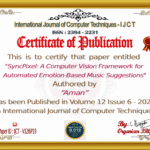
DEEPFAKE DETECTION IN KYC APPLICATION | IJCT Volume 12 – Issue 6 | IJCT-V12I6P32

International Journal of Computer Techniques
ISSN 2394-2231
Volume 12, Issue 6 | Published: November – December 2025
Table of Contents
ToggleAuthor
HARSHITH ABHISHEK M, MANOJ V, TIRUPATI C RATHOD, KARTHIK H E
Abstract
This project presents a modern deepfake detection web application designed to identify manipulated or AI- generated images using advanced artificial intelligence and computer vision techniques. The system analyzes various visual cues such as facial symmetry, edge density, skin tone consistency, and texture irregularities to determine the likelihood of deepfake manipulation. It integrates the DeepFace library for facial feature analysis along with custom OpenCV-based algorithms for more accurate and explainable results.
The application provides a FastAPI and Flask-based interface that allows users to upload images or capture selfies in real time for analysis. It generates a deepfake probability score, highlights detected anomalies, and applies dynamic thresholding—using stricter limits for identity verification (selfies) and more lenient thresholds for general image uploads. All image processing is performed locally to ensure privacy and security.
This project demonstrates an efficient and user-friendly approach to deepfake detection by combining deep learning with traditional image analysis methods. The result is a reliable, privacy-preserving tool capable of real-time detection and detailed reporting of potential image manipulation.
Keywords
^KEYWORDS^
Conclusion
The development of deepfake technology has introduced both innovation and risk into the digital world. While it showcases the potential of artificial intelligence in creative and entertainment industries, it also poses serious challenges to authenticity, privacy, and public trust. This project aimed to address these challenges by designing and implementing a hybrid, explainable, and privacy-preserving deepfake detection system capable of identifying manipulated or AI-generated images with high accuracy.
The proposed system effectively combines DeepFace for facial feature analysis and OpenCV for traditional image processing techniques such as symmetry evaluation, edge detection, and texture analysis. Through dynamic thresholding, the model intelligently adapts its sensitivity based on the image context—using stricter criteria for identity verification (selfies) and more lenient parameters for general uploads. This adaptive design reduces false positives and enhances classification reliability across diverse scenarios.
A major strength of the system lies in its local processing capability, ensuring that all analysis occurs securely on the user’s machine without transmitting sensitive data to external servers. This privacy-focused design aligns with modern data protection standards and makes the system suitable for real-world applications such as digital KYC, content verification, and forensic investigation.
The project also emphasizes explainability, providing users with not just detection outcomes but detailed reasoning behind each result. By clearly highlighting anomalies such as facial inconsistencies, color imbalances, or texture irregularities, the system enhances transparency and user confidence.
Overall, this project demonstrates that combining artificial intelligence with classical computer vision techniques can create a powerful and efficient deepfake detection framework. The system offers a balance between accuracy, interpretability, and usability, setting a strong foundation for future advancements in the field. With further optimization—such as real-time video analysis, audio-visual integration, and advanced model training—this framework can evolve into a comprehensive tool for safeguarding digital integrity and combating the growing threat of synthetic media.
References
1)Afchar, D., Nozick, V., Yamagishi, J., & Echizen, I. (2018). MesoNet: A Compact Facial Video Forgery Detection Network. IEEE International Workshop on Information Forensics and Security (WIFS), pp. 1–7.
2)Rossler, A., Cozzolino, D., Verdoliva, L., Riess, C., Thies, J., & Nießner, M. (2019). FaceForensics++: Learning to Detect Manipulated Facial Images. IEEE/CVF International Conference on Computer Vision (ICCV), pp. 1–11.
3)Li, Y., Chang, M. C., & Lyu, S. (2018). In Ictu Oculi: Exposing AI Generated Fake Face Videos by Detecting Eye Blinking. IEEE International Workshop on Information Forensics and Security (WIFS), pp. 1–7.
4)Matern, F., Riess, C., & Stamminger, M. (2019). Exploiting Visual Artifacts to Expose Deepfakes and Face Manipulations. IEEE Winter Applications of Computer Vision Workshops (WACVW), pp. 83–92.
5)Korshunov, P., & Marcel, S. (2019). Vulnerability Assessment and Detection of Deepfake Videos. International Conference on Biometrics (ICB), pp. 1–6.
6)Dolhansky, B., Bitton, J., Pflaum, B., Lu, J., Howes, R., Wang, M., & Ferrer, C. C. (2020). The DeepFake Detection Challenge (DFDC) Dataset. arXiv preprint arXiv:2006.07397.
7)Tariq, S., Lee, S. W., Woo, S. S., & Shin, S. Y. (2021). A Deep Learning-Based Approach for Detecting Deepfakes Using Facial Expression Analysis. IEEE Access, 9, 30277–30288.
8)Nguyen, T. T., Nguyen, C. M., Nguyen, D. T., Nguyen, D. T., & Nahavandi, S. (2019). Deep Learning for Deepfakes Creation and Detection: A Survey. arXiv preprint arXiv:1909.11573.
9)Verdoliva, L. (2020). Media Forensics and DeepFakes: An Overview. IEEE Journal of Selected Topics in Signal Processing, 14(5), 910–932.
10)Tolosana, R., Vera-Rodriguez, R., Fierrez, J., Morales, A., & Ortega-Garcia, J. (2020). Deepfakes and Beyond: A Survey of Face Manipulation and Fake Detection. Information Fusion, 64, 131–148.
How to Cite This Paper
HARSHITH ABHISHEK M, MANOJ V,
TIRUPATI C RATHOD, KARTHIK H E (2025). DEEPFAKE DETECTION IN KYC APPLICATION. International Journal of Computer Techniques, 12(6). ISSN: 2394-2231.












